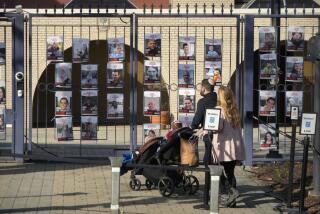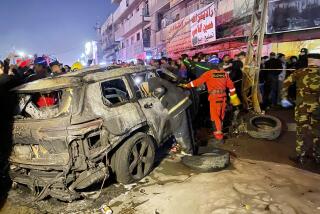Fourth U.S. drone victim influenced by Sept. 11, war
WASHINGTON — In his early teens, Jude Kenan Mohammad was a familiar sight in his middle-class section of Raleigh, N.C., riding around on his bike to deliver groceries to elderly Muslim neighbors.
But with an American mother and Pakistani father, Mohammad felt caught between two worlds, friends recalled. As he grew older, the mild-mannered young man criticized the U.S. war in Afghanistan and believed that he was a target for discrimination in post-Sept. 11 America, the friends said.
Weeks before his 20th birthday, apparently at the urging of a North Carolina man who later pleaded guilty to terrorism charges, Mohammad left Raleigh for Pakistan “to engage in violent jihad,” according to a federal indictment.
Three years later, in 2011, he was killed in a U.S. drone strike, Atty. Gen. Eric H. Holder Jr. disclosed this week.
Mohammad, shown in his FBI photo as a smiling, handsome teenager with a close-cropped beard, is the least well known of the four American citizens whom the Obama administration on Wednesday acknowledged it had killed in drone attacks overseas since 2009. The others — radical preacher Anwar Awlaki, Awlaki’s teenage son Abdulrahman and alleged Al Qaeda propagandist Samir Khan — were killed in Yemen in 2011 and had been the subject of numerous news reports.
U.S. officials offered scant details of Mohammad’s death, saying only that he was “not specifically targeted.” That seemed to indicate that he was killed in a so-called signature strike, aimed at individuals whose identities aren’t known but who are engaged in suspicious behavior.
Family members believe he died in a November 2011 strike that killed at least 12 people in a compound in South Waziristan, a Pakistani tribal region on the border with Afghanistan.
Former U.S. officials said that even if Mohammad wasn’t the target of the strike, he was of interest to American intelligence because he was believed to have communicated with Muslims in the United States and encouraged them to travel to Pakistan or carry out attacks at home.
In his 2012 book “Hunting in the Shadows,” Seth Jones, a Rand Corp. terrorism analyst and former advisor to the U.S. military’s special operations command, wrote that U.S. officials believed Mohammad had helped persuade five young men from northern Virginia to attempt to wage jihad by traveling to Pakistan, where they were captured in 2009.
“His profile had been elevated by his involvement in the recruitment of Americans,” Jones said in an interview.
Mohammad’s journey from a suburban upbringing in Raleigh to Pakistan’s insurgent-ridden tribal area is the latest tale of a young Muslim, disillusioned in America, who allegedly sought comfort in violent extremism. His story bears similarities to that of Tamerlan and Dzhokhar Tsarnaev, the brothers suspected in the Boston Marathon bombings, young Muslims who were raised in the U.S. suburbs but felt the emotional tug of their parents’ war-torn homeland of Chechnya.
News of Mohammad’s death did not surprise friends in North Carolina, who had heard reports of the drone strike in 2011, but served as a reminder of a quiet young man who became radicalized in plain sight.
“He was part of that 9/11 generation,” said Khalilah Sabra, an immigration lawyer whose son was friends with Mohammad. “He was sensitive to the Islamophobic remarks and a lot of the religious discrimination that happened after 9/11.”
Born in Florida, Mohammad grew up in the Raleigh area with his mother, Elena, who had converted to Islam, and four sisters. His parents divorced when he was young and his father returned to Pakistan, friends said.
Mohammad was a fixture at youth activities and Friday prayers at the local Islamic center. After school, he could be seen piling fruits and vegetables onto the back of his bike to take to neighbors. Sabra sometimes folded his bike into the back of her van and drove him around to make deliveries.
“If someone needed their grass cut, he would cut their grass. If they needed help moving, he would help,” Sabra said. “It was his nature. But like all kids, when they turn 17 or 18, they go through a transition.”
After he dropped out of high school and moved in with roommates, he started espousing political views, mainly about the war in Afghanistan, which he called “unjust.”
Friends saw the roots of Mohammad’s transformation in his relationship with Daniel Patrick Boyd, a drywall contractor who converted to Islam and took the name Saifullah, meaning “Sword of God.” In 2009, Boyd was charged as the ringleader of a group of seven young men, including Mohammad, who were stockpiling weapons and plotting to carry out terrorist attacks overseas.
“His political opinions were basically molded by Daniel Boyd,” Sabra said. “He had come to a point where he felt like he was out of place in America. He was unable to sustain a good living here. He told friends that his father lived in Pakistan and he wanted to see a different side of life.”
Authorities believe that Mohammad left for Pakistan around Oct. 7, 2008. About a week later, Pakistani authorities arrested him for illegally trying to enter the tribal region along the Afghan border, where Al Qaeda and Taliban militants have long maintained strongholds.
Local officials said police caught him in a rented car and carrying weapons. In a court appearance a few days later, wearing a traditional Pakistani tunic and baggy trousers, Mohammad said he was innocent. He was jailed for seven days and released, but skipped bail and fled, officials said.
Sabra last heard from Mohammad in the summer of 2011, around the time of Muslims’ annual Eid holiday, when the young fugitive said he had married and was expecting a child.
“He said life was difficult there, but he felt happy. He was content,” she said. “I asked him, ‘Are you going to come home?’ And he said no.”
Times staff writer Alex Rodriguez in Islamabad, Pakistan, contributed to this report.
More to Read
Start your day right
Sign up for Essential California for news, features and recommendations from the L.A. Times and beyond in your inbox six days a week.
You may occasionally receive promotional content from the Los Angeles Times.







